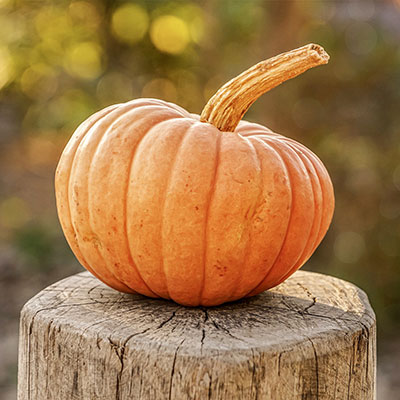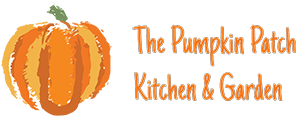
Earlier this month, we spoke with Lisa Fearn from The Pumpkin Patch to talk about the importance of getting children into gardening and the valuable skills they can learn from doing so. Lisa spoke to us about the classes The Pumpkin Patch run, favourite recipes for homegrown food, and seasonal cooking.
Our interview with The Pumpkin Patch

1. You have five children of your own who all love gardening. How did you get them into it to start with?
It wasn’t a matter of getting them into it, they just started helping in the garden. When they were very little they used to play in a sand pit just next to me in the garden. I’d dig the soil and they would dig in the sand! They soon started joining me in the garden and would help to plant up young plants and sow seeds… usually all over the place, but it didn’t matter. We just used to see where they’d pop up!
2. You’ve taken the enthusiasm your own children have for growing and harvesting food and started The Pumpkin Patch kitchen and garden school. How much do you believe your work benefits local children and families?
One of the original aims of the cookery school was to EDUCATE children about food and diet, where it comes from, how we grow it, and what we can do with it. It's not all sugar and sprinkles at the Pumpkin Patch. We grow and harvest our vegetables and we teach about traditional and wholesome family food.
Numeracy and literacy are discussed while children weigh and prepare their ingredients. The difference between a currant and a current, and how they differ from raisins and sultanas, and where they grow in the world is an important part of a Pumpkin Patch workshop.
Children and parents alike LEARN new and interesting relevant facts about food and cookery. WE often have private lessons for school groups, groups and organisations; we see children's confidence grow as they mix with new children and learn in a non-school environment.
3. How important is it that children are taught about their food and how to harvest it from a young age?
Knowledge about our food affects the way we eat and cook, and this will result in improved health, which will filter through to the next generation.
Cooking and gardening are two skills that have been lost somewhere during the past two generations. We offer gardening (grow your own) as part of the cookery workshops, and link into other related topics including information about food, diet, composting, recycling and the wider global issues relating to food. Nutrition and health, both physical and emotional are also included. As The Pumpkin Patch strives to educate people about the benefits of healthy eating, it uses traditional Welsh recipes that have been handed down through the generations.
4. You offer a range of classes and parties on your website to help get adults and groups of children interested in growing and making their own food. What sort of topics do you cover in your classes?
- How to create a raised bed for a veg patch
- How to plant it up, with easy to grow veggies and fruit
- How to look after them, water them, weed the patch, harvesting & storage.
- How to cook them or prepare them, what to make with the wonderful harvest
5. You try to use seasonal produce in your classes. What sort of recipes can you cook with pumpkins or squashes?
We make the obvious things such as pumpkin soups and stews & tagine. I like to think a pumpkin or a squash can be used in any recipe that uses sweet potato. I’ve made pumpkin cake which includes the grated flesh of the pumpkin. Another good recipe is roast pumpkin with spices such as paprika and cajun spices for a bit of a hot kick. Combine the roasted spiced soft flesh with some cream cheese to make a dip for fresh bread.
6. A lot of people know about sloe gin, but are there any other recipes you could recommend to use sloes or damsons in?
I love a damson and autumn berry compote which is great in a crumble or use it as a topping for ice cream or in the base of an autumn fruit trifle. For breakfast, add it to your granola and yoghurt. It’s totally versatile!
To make it:
Slice your fruit, and remove any stones. I use nectarines or peaches that may be passed their best. Place ½ Tbsp butter in a frying pan, add the fruit and fry until
heated through. Add the other soft fruit, such as autumn raspberries or some late strawberries - I actually harvested a handful last week (mid-October). Plums are great too!
Add enough sugar to sweeten, this will depend on which fruit you use.
Add your free autumn berries, such as blackberries and damsons, & cook for a few minutes to soften. Allow to cool then store in the fridge or freeze until you need it.
7. Do you have a favourite seasonal recipe to make?
Butternut Squash with Coconut
Ingredients
- 500g shallots
- 1.5kg squash deseeded and roughly chopped
- 2tbsp veg oil
- 3 red peppers deseeded and roughly chopped
- 3 cloves of Garlic
- 2tbsp of Cajun seasoning
- 150ml veg stock
- 400ml can of coconut milk
- 400g can of chopped tomatoes
- oil for frying
Method
- Heat 2tbsp of oil in a large saucepan, add the peppers and shallots and fry gently for 10 minutes, stirring frequently, until softened and browned.
- Add the squash, garlic and Cajun seasoning with the coconut milk, tinned chopped tomatoes and the stock
- Bring to the boil, and then reduce the heat. Cover and cook gently for 45 minutes, stirring occasionally, until the veg are tender.
- Leave to cool off 10 minutes before serving.




